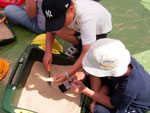History kits (“trunks,” “boxes,” etc.), available for rent or purchase, have attracted attention from school districts, museums, and funders as a tool for integrating material culture into history instruction, and rightly so. As a museum educator and historian, I often witness the power of “stuff” (aka material culture) to connect students of all ages to historical events and people that might otherwise seem both remote and irrelevant. ()
As an educator once cautioned me, however, “The world is full of dead kits.” You may have come across some yourself—boxes full of objects and notebooks stuffed with resources and lesson plans—developed with the best intentions and often at some expense, yet languishing on museum shelves or in curriculum directors’ offices. No matter how attractively packaged and thoughtfully conceived, using neat stuff in a history classroom is no slam-dunk.
...districts need to devote time and resources to professionally developing K–12 educators in the effective use of material culture in the history classroom.
Ultimately, efforts to enliven and deepen history instruction come down, as in so much else, to the teacher. This means that districts need to devote time and resources to professionally developing K12 educators in the effective use of material culture in the history classroom. Even high school teachers confident in their ability to use primary source documents with students typically lack training in teaching with material culture. Without such training, even the most inspiring history kits are likely to stay on the shelf.
The Deerfield Teachers’ Center (DTC) has found that combining teacher training in material culture with access to well-designed history kits is an effective strategy for improving history instruction. Best of all, it is a replicable model. Museums with robust education programs welcome opportunities to work with schools and teachers to develop strategies and materials to bring material culture into the classroom.
The Deerfield Teachers’ Center has created nine Traveling History kits to meet the needs of teachers and students. Designed around historical events, topics, and themes ranging from early exploration and contact to World War II, kits contain reproduction objects, images, music, and documents as well as contextual information and teacher background materials. Each item is carefully selected for inclusion based on its capacity to convey essential content and to promote skills of historical thinking and critical analysis in elementary and high school students. So far, so good. But how to encourage teachers to use these rich resources in their classrooms?
This is where teacher training in material culture comes in. Educators who attend DTC professional development interact with material culture in workshops and seminars. Teaching American History (TAH) project participants also select and observe a History Lab in their own classroom. In-class History Labs taught by DTC staff are organized around specific topics and themes and model teaching with a variety of primary sources, including material culture, to meet specific learning objectives. These experiences build teacher interest and confidence in using material culture; educators report that they routinely include such sources in their own teaching as a result of the training they received.
Hands-on, collaborative interaction with the “stuff” of history helps students to connect abstract concepts communicated through documents and secondary sources to human experience.
Embedding material culture in its historical context extends and deepens students’ knowledge beyond superficial memorization of dates and factoids. Hands-on, collaborative interaction with the “stuff” of history helps students to connect abstract concepts communicated through documents and secondary sources to human experience. Teachers and students take tea 18th-century style using reproduction tea equipage in the Tea Tax Tempest kit as they consider the role tea played in English social, economic, and political life on the eve of the American Revolution. ()
The Made in America History Lab models for teachers how to use kit items to explore with students the role of a colony in the British Empire and offers students tangible evidence of the mercantilist assumptions that informed British economic policies. Access to this rich material culture also offers teachers alternatives to historically inaccurate activities involving appealingly tactile puffs of batting and sheep-to-wool textile stories that reinforce the myth of colonial self-sufficiency.
Not surprisingly, teachers who have observed a History Lab program are much more likely to use a history kit on their own. And, of course, kits are fun to use! Teacher training in material culture combined with access to well-designed history kits is a winning combination for any American history classroom. Is there a history kit on your shelf?
Footnotes
For a fascinating discussion of the potential power, utility, and methodology of using material culture to forward historical understandings, see Jules David Prown and Kenneth Haltman, eds., American Artifacts: Essays in Material Culture (East Lansing: University of Michigan State Press, 2000).
T.H. Breen, “Baubles of Britain,” Past & Present, 119 (May 1988): 73104; Rodris Roth, "Tea Drinking in Eighteenth Century America: Its Etiquette and Equipage," in Material Life in America, 16001860, ed. Robert Blair St. George (Boston: Northeastern University Press, 1988), 439463.
